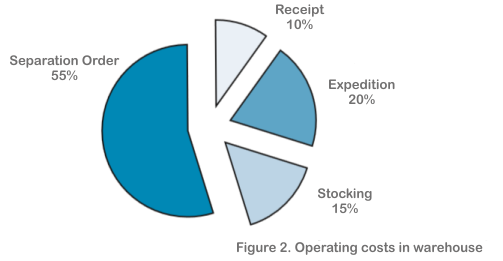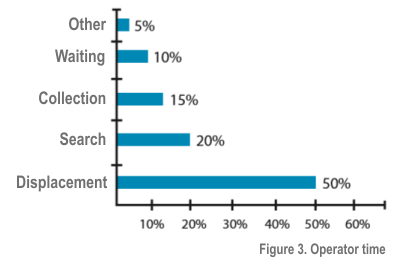WMS: Advantages and Risks in Implementing
How to conduct the process of setting up and implementing a WMS tool to extract gains.
Currently, the ” background ” in the operation of firms is constant pressure for a more efficient management of resources (material, financial and human). In this market where the search for competitiveness and productivity level of service to customers (internal and external), pressure by decreasing margins, increased competition and globalization are part of everyday business, the area of Logistics, one of the most dynamic enterprises, constantly seeking models and support tools. In logistic whose focus is the integration and management of resources in order to meet growing customer demands for quality, information shall become essential in this model. The consequence is a high demand for tools WMS (Warehouse Management System) and implement the same in companies of all sizes and areas, aiming agile and reliable information.
What is a WMS?
But after all what is a WMS? What should it cover? Regardless of your academic conceptualization, the WMS is a software which aims to support the operational process of moving and storage, noting the variables that are under its responsibility: space, operators, equipment and products, integrated with other enterprise systems. The WMS uses the parameterization taken by the manager to, in an integrated manner and according to predefined policies, manage the resources more efficiently. At the end, all this control should be made explicit in the form of indicators of the operation. It is important to note that a WMS tool can optimize the company’s business into two broad fronts: reducing costs by improving the efficiency of all operational process and increase the quality of services to clients via error reduction and separation failures, inventories and meeting demands.
Macro view
Before we implement something that does not meet the company’s expectations, wants to be a “white elephant” of high complexity or a simple tool for inventory control who calls himself WMS, we develop a detailed analysis of the processes for identifying improvements in compliance with the characteristics of each company. A standard solution of WMS, the macro view of the software should cover the following aspects:
A) Control Ordinance Identification of carrier, driver, vehicle. Control courtyard and direction to the docks. Possibility to control scheduling via windows carriers.
B) Blind Conference blind receiving input, installation of standard pallet racking, identification tags. Support cross docking and quality / quarantine.
C) Storage Automatic Addressing considering ABC class handling, storage restrictions, weight, volume, product families, etc.
D) Separation generated waves of displacement by optimizing separation delivery zone, carrier, preferred customer, etc.. Using the concepts of FEFO (first beat), FIFO (first entered). Identify characteristics of products (offal, magnitudes) to break the task of separation.
E) Replenishing areas automatically restock addresses picking through parameterization of occupation.
F) Blind Shipping Conference departure, issuing dispatch labels, check out.
G) Inventories generally rotating inventories.
H) Tax (if operation of general storage) Issuance of NFS storage return, tax records storage, sintegra, etc.
I) Integration with ERP Integration with ERP via automated database or text files for entries, return status of products and adjustments of quantities.
J) Indicators (KPIs) index separation busy weight breakdowns, OTIF etc.
K) Via Collecting data collectors RF (barcode) or paper maps in port
Some numbers
One of the major problems in the implementation of any software is the justification of the need for this automation. Currently, the costs associated with handling and storage process represent around 30% of the total logistics cost and its share has been growing in recent years. Moreover, if we analyze the distribution of operating costs in the warehouse (Figure 2), it is clear the importance of control tools that manage these tasks to implement them with greater precision and efficiency.
A key point in this study is the time distribution of the operator (Figure 3). The assessment that the time spent by operators is the embodiment of tasks with productivity is key. That is, a process supported by operating well-designed tool to identify where and how to seek merchandise, optimizing shifts and downtime, allows considerable cost reduction.
Thus, it is clear that the WMS solution allows a very positive feasibility analysis to the extent that we can reduce rework and extra hours, identifying worker productivity. Inventory costs, failures and losses, difficulties in controlling lifespan of products are also reduced, from the manager to have more time to changes in the operation rather than ” put out fires “.
Benefits
Research conducted by the Gartner Group indicates that the use of a WMS tool provides an average gain of space between 10% to 20%, reduced inventory by 50% in 3 years and an accuracy of inventories in the range of 99.5%. These statements reflect the numerous benefits of the software, such as increased stocking density optimizing spaces, rationalizing routes operators, reduced roles in the operation, ease in locating product considering its expiry dates and entry, significantly improving the accuracy inventory, planning of resources (personnel, space and equipment) and even supporting increased productivity variable remuneration policies. The stores become able to assimilate without major impacts differentiated additional services requested, firmly supporting the process of increasing value to the customer. The analysis of the feasibility of implementing a WMS deployment project involves the clear opportunity to prepare the warehouse for future moments of expanding sales, reducing service time and consequently improves the image of the company as a whole, the possible cost reductions afforded in generating roles, too many people in the operation and rear depending on the need not to automated control, reduction of time and with the audit of what was done, not to mention the tragic loss of sales due to lack of products have imagined or unnecessary maintenance of obsolete or damaged goods in stock. The result is great benefit to managers is a ” cockpit ” of the operation indicators. The control of the entire resource productivity are displayed evaluating policies and processes defined above. With real-time information of the entire operation, the manager can check the results, and anticipating potential trouble spots and trends, allocate resources and take corrective and preventive measures mainly.
Deployment Process
After the green light to start of work on deployment, the focus should be directed to the review of all processes, with the aim of identifying what should be kept, what should be changed and what should be eliminated. The implementation of a software of this size is firstly the definition of a project, with a clear scope of what we want to achieve and what the responsibilities of everyone. The determination of key users is critical, as these will be responsible for project success and become the internal multipliers. These users must be on a team in multi-area company (Logistics, Management, Supervisory, etc..) And integrated with the internal IT staff and with officials of the external forncedor tool. This team will study all of the WMS integration with existing software, as well as a survey of all the resources required for implementation (personnel, hardware, etc..). However, the major responsibility of this team is to determine the stages of the project with their checkpoints and what the expected with the adoption of WMS results.
Difficulties and errors
What is true, however, is that after all implementation planning, a few points should be carefully observed for a course correction if needed. There are difficulties in deployment and are not resolved can lead to total failure of every effort hitherto employed. Some difficulties and common errors are:
A) the temptation to change the scope of the project during its execution – That ” opportunity ” to take the implementation of WMS to try to remedy at once other problems that often have nothing to do with it. This error, accompanied by unrealistic schedules, or the opportunity to ” automate wrong “, disabling the deployment and leave without a purpose;
B) lack of monitoring of management, managerial, operational and IT teams in the deployment process, besides the non- creation of internal multipliers. All these bring support a deployment of this size needs. We should also highlight the importance of being present heavily in IT systems integration. Despite the increase in the facilities of these integrations in the technical aspect, a major concern must be observed in testing quality;
C) does not involve opinion leaders in the operational phases of the project team – Besides allowing to discuss details of the operation that often only operators know who will need technical solution resolves possible resistance to the deployment process. It is essential to show the operating personnel the importance that they have in the implementation of WMS and ” sell” the process of WMS thereto;
D) do not develop adequate or unsatisfactory training times. If any change in process or software deployment steps for training and monitoring are fundamental in a deployment job WMS become the ” watershed ” between the success and failure of the project. The integration between physical and logical is full and if the operator does not follow the designed process, it is difficult to extract the expected results;
E) the audit of all results obtained at checkpoints is important for any adjustments route, charging or maintenance responsibilities towards adopted. Do not do this task is to run the risk of reaching the end of the project with something that was not expected goal.











